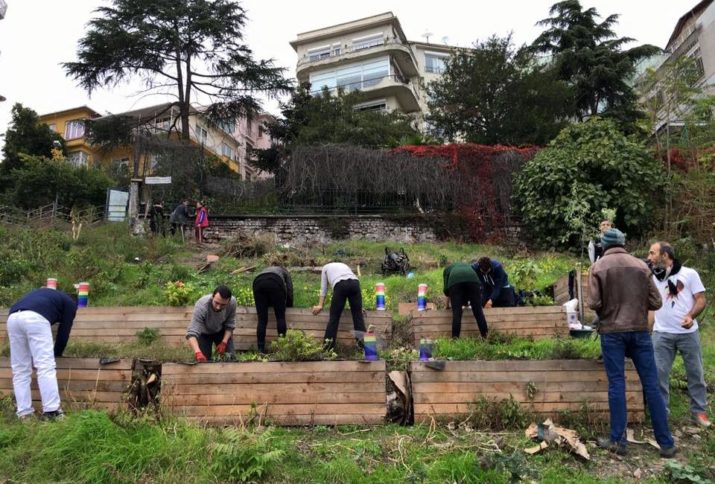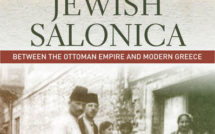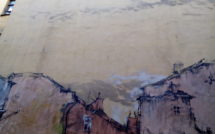

This is part of our special feature, Contemporary Urban Research in the European City.
Philosophers Micheal Hardt and Antonio Negri define the dominant model of production as “‘biopolitical production’ to highlight that it not only involves the production of material goods in a strictly economic sense, but also touches on and produces all facets of social life: economic, cultural, and political. This biopolitical production and its expansion of the common is one strong pillar on which stands the possibility of global democracy today.” (2004, 16). The authors suggest that the commons is not something shared but rather it is produced (2004, 15). They further presuppose a definition of commons that do not only involve the resources, but also a set of relational processes, which are partly created by new spaces and actors. It is possible to say that acting in a space contributes to commoning. The more the people live and act in a space, the more they make it a public space (Harvey, 2012), which also refers to a concept of commons as “practice” (de Certeau, 1984) or commons in action (Robles-Duran, 2014). In most cases, the lack of consensus on an environmental and economic future in Europe create new dynamics for common making through collective movements, as well as new modes of sociability, rethinking the wider paradigms of movement and spatial access in contemporary culture.

The research network TACT has been born out of a need to create a link between people working on similar issues in various cities. A recent project supported by the Alexander von Humboldt Foundation “Claiming the Public Space,” focuses on issues such as horizontal planning, right to the public space and urban access through interventions. In the summer of 2017, as part of the summer workshop ‘Dialog at Water: peer to peer education’ we were invited to participate in discussions as members of TACT. The main theme of this gathering was the various cases of urban waterfront in St. Petersburg, such as a site near the canal in the urban center, or the less populated areas near the western coast by the sea. During the workshop, there were various excursions in the urban center—the space of a discontinuous spatial agglomeration—such as the market space composed of goods from the post-soviet republics, or a Chinatown hidden in the heart of the city, which raised many questions regarding the material attributes of the effects of globalization in the urban space.
During the workshop, I participated in a walking act as urban exploration, on a route suggested initially by a participant of the workshop in the west of the city. The act of walking this specific route at Kanonersky district for the first time, which was previously defined as the city’s wasteland, was now filled with green areas with bushes, trees, and grass on a sandy soil. The area stood just beneath the grand port of St. Petersburg in the west, which was organized to respond fast to the needs of global economic circulation. While walking in the old wasteland, the port appeared and disappeared nearby, contrasting visually and aurally with this seemingly disorganized part of the city. The area was neither attractive nor inviting. Towards the end of the walk, when we met the sea, the gated community-shopping-mall-complex seen afar, erected on one of the islands of St. Petersburg, Vasileostrovsky district, reframed the landscape, while we were looking and thinking simultaneously across the conceptualizations of urban nature.

This experience intertwines with an act of urban gardening in Istanbul. Building Roma Community Park, a group of people revived the historical gardens recently; and harvesting the soil, they engaged in an act of urgency to claim urban public space, rejecting the plans to build municipal housing on this land.
Debates on the shrinking public space in Istanbul are not new. Since the last two decades, they have been crystalized in relation to the topics such as the regeneration of old neighborhoods, protecting heritage, the right for the waterfronts and green spaces, as well as the public but unused spaces, revived with old or new ways of usages. Since the 2010s, increasingly, various gatherings in the neighborhood scale, achieve in creating communities contributing to co-imagining new forms of public culture. In an active discussion on the urban, sometimes artistic strategies intervene towards more complex discussions of public/private space. In various other cases, communities gather to make up the public space by forming a network of people including city dwellers, artists and researchers. Recently, more subtle ways of claiming the city appeared in form of artistic and neighborhood interventions, with activities such as walking, urban gardening, festivals taking place in threatened public buildings, food markets and collective sports in parks, with a backdrop to produce the commons in the public spaces.
This, at times, is also a consequence of the inhuman scale of fast developing projects and big investments in the real estate sector, as well as rising concerns for the threats against the ecosystem and the reduction of green spaces in a highly populated metropolis. For example, the new grand airport project, which is situated in a vast area in the northern forests of Istanbul, is combined with the discussion of the loss of a green park area: the loss of the public space, as well as the threatened balance of Istanbul’s ecosystem.
Within this wider context, acting in urban space with a gardening activity in the Roma Community Park, which is located in the center of the city, is out of a desire to process based and participatory practice. This practice acted in contrast to the stabilizing forms of representation that attempted to justify the initiation of a building complex in the same space. As the privatization of public space and the expanding real estate market have been transforming many neighborhoods in the city, this type of intervention attempts to construct a social space, initiating and negotiating urban access to public space, allowing participants to work in a community. It also triggers action in the city, thereby connecting the issues beyond the neighborhood scale.
In this sense, the walking in St. Petersburg and an urban garden in Istanbul, exemplify the attempts to construct social spaces with created resilient practices at different levels, which illustrate a series of threads in unused urban public space. These cities are unique but, at the same time, face similar challenges of globalization when it comes to accessing urban public space. Within less hierarchical models of walking and gardening as community practice, both acts offer critical perspectives, which are more than just observation and adaptation, but catalysts for urban activation and commoning in action.
Ayse Erek, PhD has a research focus on the urban imaginaries in the context of political and cultural discourse, contemporary art and exhibiting practices in Istanbul and Berlin. She is interested in the ephemeral memories, material culture and history of modernity. She co-edited a special issue of Visual Resources Journal titled ‘The Imaginary City in the Twenty-First Century’. Erek was a post-doctoral research fellow at Georg-Simmel Center for Metropolitan Studies of Humboldt University in Berlin, is an Associate Professor and the director of Design Graduate Program at Kadir Has University in Istanbul.
References
De Certeau, M. (1984) The Practice of Everyday Life. trans. S. Randall. Berkeley: University of California Press.
Hardt M. and Negri, A. (2005). War and Democracy in the Age of Empire. NY: Penguin Random House.
Harvey, D. (2013) Rebel Cities: From the Right to the City to the Urban Revolution. NY, London: Verso.
Robles-Duran, M. (2014) Make_Shift City: Renegotiating the Urban Commons. Berlin: Jovis.
Roma Community Park Website: http://romabostani.org/?page_id=2&lang=en, accessed in April 3, 2018.
Images
Image 1. Roma Community Garden, Istanbul.
Image 2. Kanonersky district, St. Petersburg. Looking at the Vasileostrovsky Island. Photo: AE.
Image 3. Roma Community Garden, Istanbul.
Published on May 1, 2018.




